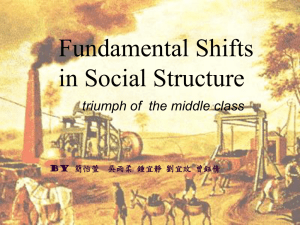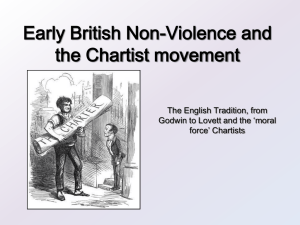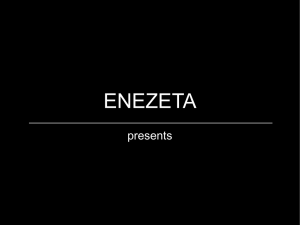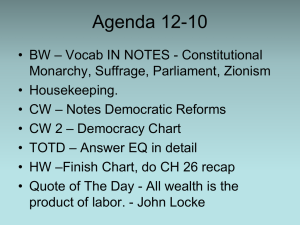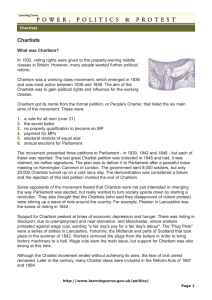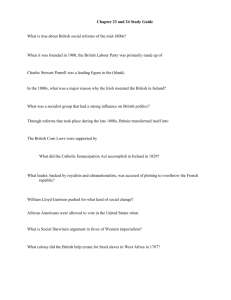Document 13726070
advertisement
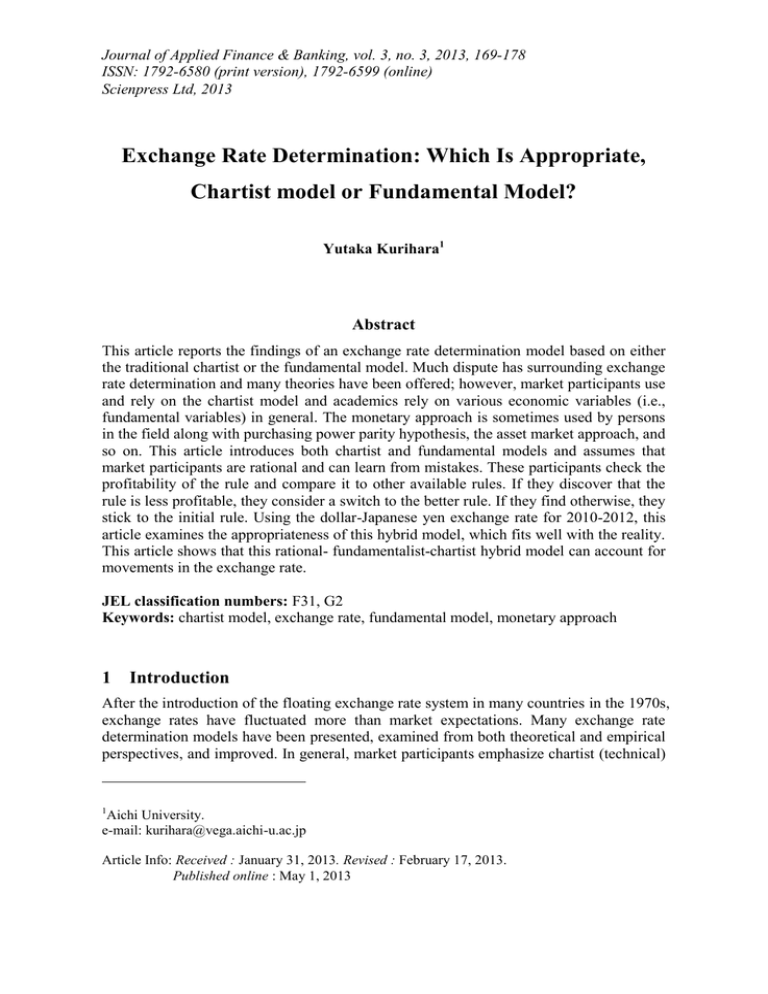
Journal of Applied Finance & Banking, vol. 3, no. 3, 2013, 169-178 ISSN: 1792-6580 (print version), 1792-6599 (online) Scienpress Ltd, 2013 Exchange Rate Determination: Which Is Appropriate, Chartist model or Fundamental Model? Yutaka Kurihara1 Abstract This article reports the findings of an exchange rate determination model based on either the traditional chartist or the fundamental model. Much dispute has surrounding exchange rate determination and many theories have been offered; however, market participants use and rely on the chartist model and academics rely on various economic variables (i.e., fundamental variables) in general. The monetary approach is sometimes used by persons in the field along with purchasing power parity hypothesis, the asset market approach, and so on. This article introduces both chartist and fundamental models and assumes that market participants are rational and can learn from mistakes. These participants check the profitability of the rule and compare it to other available rules. If they discover that the rule is less profitable, they consider a switch to the better rule. If they find otherwise, they stick to the initial rule. Using the dollar-Japanese yen exchange rate for 2010-2012, this article examines the appropriateness of this hybrid model, which fits well with the reality. This article shows that this rational- fundamentalist-chartist hybrid model can account for movements in the exchange rate. JEL classification numbers: F31, G2 Keywords: chartist model, exchange rate, fundamental model, monetary approach 1 Introduction After the introduction of the floating exchange rate system in many countries in the 1970s, exchange rates have fluctuated more than market expectations. Many exchange rate determination models have been presented, examined from both theoretical and empirical perspectives, and improved. In general, market participants emphasize chartist (technical) 1 Aichi University. e-mail: kurihara@vega.aichi-u.ac.jp Article Info: Received : January 31, 2013. Revised : February 17, 2013. Published online : May 1, 2013 170 Yutaka Kurihara analysis in the real world, whereas academic economists prefer fundamental over chartist analysis or models. In the 1970s, a new paradigm macroeconomic and finance theory, rational expectation, appeared (see [1], [2] for examples). Compared to previous economic theories, rational expectation models provide many advantages for the formation of expectations by economic agents. Since then, this theory, which allows the use of micro-foundations in individual decisions, has been introduced in many fields of economics and finance. Exchange rate determination models have been strongly influenced by this rational expectation theory. However, the validity of this framework has not been fully accepted from either the theoretical or realistic view. The strongest argument against it is that market participants cannot understand the complexity of the economy. Recently, behavioral economists, neurologists, and psychologists have discovered inconsistences between the assumptions made by economists and the way in which humans actually behave. Behavioral economics appeared in the 1980s and has improved greatly since then. This article provides one behavioral finance model of the foreign exchange market (based on [2]). In the analysis of exchange rate price movements, both fundamental and chartist approaches need to be considered. Market participants are assumed to check the profitability of the rule and compare it to other available rules in this model. If they discover that the rule is less profitable, they consider a switch to the better rule and do it. If they find otherwise, they stick to the initial rule. Moreover, empirical analyses are performed whether or not this model fits the reality from 2010 to 2012. [3] and [4] showed that heterogeneous market participants are active in the yen/dollar market whereas the stabilizing force from the fundamentalists declines in large misalignments. Recently, in the field of behavioral finance, [5] showed that market participants first select the optimal behavioral portfolio theory, overlook covariances among markets, and allocate funds across markets according to a rule to attain mean-variance efficiency or to minimize the loss. However, little research has analyzed exchange rates while considering expectation formation, especially behavioral finance. This article is structured as follows. After this introduction, section 2 provides a theoretical model for empirical analyses. Section 3 performs empirical analyses, examines the results, and analyzes whether or not this rational-fundamental-chartist hybrid model is capable of accounting for the movement of exchange rate in reality. Finally, a brief summary concludes the article. 2 2.1 Theoretical Model Conceptual View This section shows a rational-fundamental-chartist hybrid model that seems useful not only from an academic perspective but also from a realistic perspective. This model is expected to explain the movements of exchange rates much more than do other models. However, some assumptions are in place for this model. First, individual market participants have cognitive limitations on their information. They are not capable of understanding the complexity of the model. Second, they know their knowledge is not perfect. This article presents a rational expectation model. Market participants cannot Exchange Rate Determination: Chartist model or Fundamental Model? 171 fully acquire and process information, but they use as much information as possible and act based on this bounded rational expectation rule. Market participants act as follows: they check the profitability of the rule and compare it to other available rules. If they find that the rule they adopt is less profitable, they consider a switch to the better rule and act accordingly. If they find otherwise, they stick to the initial rule. They are not perfectly rational, but they act according to a bounded rational rule. This is the “difference limen” or “just noticeable difference” in psychology as the intensity of a stimulus that when applied to people leads to no reaction or change in behavior [2]. Generally speaking, market participants emphasize chartist analysis in the real world, whereas academic economists prefer fundamental to chartist elements. This article assumes that market participants use both fundamental and chartist models for exchange rate price forecasting and transactions. Economists in academic fields have not completely evaluated the chartist model, but evidence suggests that many market participants in the real world make forecasts based on it. No strong theory suggests that the field should disregard the chartist rule from the academic perspective. It is necessary and important to bridge both the business and academic worlds. The fundamental model here assumes that market participants know fundamental exchange rates. These participants compare the present exchange rate with the fundamental one and forecast the future exchange rate to move toward the fundamental exchange rate. This leads to the following rule as shown in equation (1). Et = (Δet+1) = - α(et – e*t) (1) where Et is the forecast made in period t by the fundamentalists using information up to time, et is the exchange rate in period t, Δet + 1 is the change in the exchange rate between period t to t + 1, e * t is the exchange rate in period t, and α > 0 measures the speed with which the fundamentalists expect the exchange rate to return to the exchange rate based on fundamental elements. This is a typical fundamental approach. 2.2 Fundamental Elements Exchange Rate Model Since the 1970s, exchange rates have started to move with asset prices, stock price, land prices, and so on. Great capital flows over GDP started to occur all over the world. Until then, exchange rates had been moving with international trade (tradable goods), but the situation has changed greatly. Some famous papers (e.g., [6], [7], [8], [9]) have considered this issue. All models of this kind rely on a stable money demand function in the following form (2): M/P = L(Y, i) (2) where M denotes the money supply, P the price level, L the money demand, Y real income, and i interest rate. A basic assumption of this monetary approach model is that the purchasing power parity holds: S = P/P* where S means nominal exchange rate and P* means foreign price. (3) 172 Yutaka Kurihara In the log linearized form, the exchange rate can be expressed as the difference between domestic and foreign money supply, real incomes, and interest rates. If the money supply and income elasticities are equal in each currency market, exchange rates are determined as follows: s = α + β(m – m*) – γ(y – y*) + δ(i – i*) (4) where α is a constant term. β, γ, and δ are (semi-) elasticities. The interest rates are expressed as percentages. So, exchange rates are expressed as follows: s = s(m – m*, y – y*, i – i*) (5) Some other strict assumptions underpin this model: real income and money market rate are at equilibrium; domestic and foreign goods are perfect substitutes; uncovered interest rate parity holds; and so on. Results from empirical literature reviews appear mixed. There seems no consensus about the validity of this model. However, this article employs this model for empirical analyses. On the other hand, the chartist model is assumed to follow a feedback rule. This article assumes that chartists employ the most recent previous period’s exchange rate information to predict the future rate. This assumption seems to be very realistic and to be employed broadly. Most participants in foreign exchange markets do not extrapolate information from past periods but extrapolate from the most recent period’s information. However, the market participants are not perfectly rational but in fact are bounded rational. In the real world, this assumption seems to be very realistic. The chartists’ forecast model is specified as follows: Et = (Δet + 1) = β(Δet) (6) where Et is the forecast made in period t by the chartists using information up to t, and β is the coefficient that measures the degree with which chartists extrapolate the past change in the exchange rate. This article assumes that 0 < β < 1. The general idea is that market participants seem to follow either the fundamental rule or the chartist rule. They are assumed to use of one the two rules, compare their profitability, and decide whether to stick with the rule or to switch to the other one. This means that the fraction of the total population of market participants that use chartist and fundamentalist rules is a function of the relative (risk-adjusted) profitability of these rules. Equations (7) and (8) specify the following procedure: populationf = Et (πf) / (Et (πf) + Et (πc)) (7) populationc = Et (πc) / (Et (πf) + Et (πc)) (8) where populationf and populationc are the fractions of the population that use fundamental and chartist rules. Of course, populationf + populationc = 1. The variables πf and πc are the risk-adjusted profits realized by the use of chartist and fundamental forecasting rules in period t. Each variable is profits made in forecasting minus μσ 2. μ is the coefficient of risk aversion. σ2 is the variance of the forecast error, σ2 = [Et-1 (et) – et]2 Exchange Rate Determination: Chartist model or Fundamental Model? 173 Equations (7) and (8) can be interpreted as follows. When the risk-adjusted profits of the chartist rule increase relative to the risk-adjusted profits of the fundamentalist rule, the share of market participants that use chartist trading rules increases and vice versa. The switch is assumed to be easy without any costs, time, and so on for the market participants. Profits in the foreign exchange markets are defined as the one-period earnings of investing foreign currency. More formally, πi,t = [et – e t-1] PLUSMINUS [E t-1 (et) – e t-1] (9) where i = f (fundamentalist) or c (chartist). PLUSMINUS [x] = 1 (for x > 0), 0 (for x = 0), or -1 (for x < 0). Finally, it can be assumed that market participants aggregate these forecasts to make forecasts. The market forecast of exchange rate change Et (Δet+1) can be written as a weighted average of the expectations of fundamentalists and chartists. Et (Δet+1) = – populationf α(et – e*t) + populationc β(Δet) (10) The realized change in the exchange rate in period t + 1 equals the market forecast made at time t plus white noise errors, εt + 1, occurring in period t + 1. The εt is assumed to be normally distributed with means equal to 0. Equation (6) can be written as follows: Δet+1 = – populationf α(et – e*t) + populationc β(Δet) +εt + 1 (11) Section 3 provides empirical analyses that mainly check whether or not this model is appropriate and determines which rule should be adopted. When exchange rate moves are large or frequent, it is important for market participants as well as for policymakers to check which rule should be employed in the foreign exchange market. Exchange rates sometimes impact economic stability and affect enterprises and broad macroeconomic activities. Moreover, exchange rate prices sometimes change dramatically and frequently. 3 Empirical analyses As mentioned in previous section, economist in academic fields has not been relied on chartist model. Chartists do not emphasize extrapolation from past information but tend to employ recent information about exchange rates. However, much of empirical evidence indicates that chartist analysis or technical analysis is appropriate and market participants make forecasts based on this approach in reality [11]. Too much dependence on fundamental analysis seems to be dangerous in the analysis of exchange rates in reality. Traders in foreign exchange markets or financial markets watch prices on a daily, hourly, or minute basis. Every minute and second, they carefully watch exchange rates as a factor in sell/buy decisions. In such cases, chartist analysis seems to and should be used much more. It is sometimes very important to bridge the business world and the academic world. For empirical analysis, exchange rates from fundamental model should be determined. The monetary model, as explained in 2.2, is employed here. The main estimation time is 174 Yutaka Kurihara from the beginning of December to the end of December in 2010, 2011, and 2012. The date which will be used is daily. The estimation period for the monetary (fundamental) model is three years in each case. The data are monthly (average). All the data are from International Financial Statistic (IMF). For example, for the case of 2010, the sample period is from October in 2007 to October in 2010. The estimated equation is (4); however, the differentials of two variables, interest rate and GDP (industrial production instead of GDP is used because of data availability), were not significant at the 10% level. So exchange rate is regressed only by money supply (M2: seasonally adjusted). The results are as follows. Figures in parentheses are t-values. All of the coefficients are significant at 1% level. <2010> st + 1 = 245.0531 + 0.019921 (mt – m*t) (21.75858) (13.34655) Adj. R2: 0.916363 <2011> st + 1 = 214.7256 + 0.015590 (mt – m*t) (19.41396) (11.55526) Adj. R2: 0.892773 <2012> st + 1 = 146.6435 + 0.007641 (mt – m*t) (16.64171) (7.269752) Adj. R2: 0.798684 (12) (13) (14) From each equation, three estimated exchange rates can be obtained. Again, the estimated exchange rates are same for each sample period (December in 2010, 2011, and 2012). Next, equation (6) is estimated. The sample period is from the beginning of January to the end of October in 2010, 2011, and 2012. The data are daily (average). The data are from Nikkei NEEDS (Japanese newspaper company). <December 1, 2010 > st + 1 = 87.53844 + 0.717390 (st – st-1) (332.9747) (1.507993) Adj. R2: 0.099375 <December 1, 2011> st + 1 = 79.77271 + 0.512831 (st – st-1) (504.1106) (1.529435) Adj. R2: 0.097644 <December 1, 2012> st + 1 = 79.75920 + 0.033458 (st – st-1) (638.3353) (3.294534) Adj. R2: 0.205566 (15) (16) (17) Exchange Rate Determination: Chartist model or Fundamental Model? 175 It should be noted that the equations (15) and (16) are not so good. The results illustrate one reason that too much dependence on the chartist model is sometimes dangerous. Figures 1, 2 and 3 are the exchange rate movements from the beginning of December to the end of this month in each year (2010, 2011, and 2012). The upper part shows the simulated exchange rate obtained from the simulation and the exchange rate in reality. The lower part shows exchange rate derived from chartist analysis. Exchange rates in the real world are included in each figure for comparison. Figure 1: Simulated Exchange Rate in 2010 (December) 85.00 84.50 84.00 83.50 83.00 82.50 Yen/Usdollar 82.00 simulation 81.50 chart 81.00 80.50 80.00 79.50 1 3 5 7 9 11 13 15 17 19 21 Figure 2: Simulated Exchange Rate in 2011 (December) 78.20 78.10 78.00 77.90 Yen/Usdollar 77.80 simulation 77.70 chart 77.60 77.50 77.40 1 3 5 7 9 11 13 15 17 19 21 176 Yutaka Kurihara Figure 3: Simulated Exchange Rate in 2012 (December) 87.00 86.00 85.00 84.00 Yen/Usdollar 83.00 simulation 82.00 chart 81.00 80.00 79.00 1 3 5 7 9 11 13 15 17 19 These figures show that the movement of the simulated exchange rate is similar to the reality. It can be said that this bounded rational- fundamentalist-chartist mixture model is suitable for the analysis of exchange rates, and the results seem to be as expected. Market participants might rely on the fundamental approach when exchange rates vary from the simulated ones; on the other hand, market participants might rely on the chartist approach when the departures are small. Finally, the standard deviation of the simulated exchange rate and the exchange rate in the real market are calculated. Table 1 shows the results. Standard deviation Variance Kurtosis Skewness Table 1: Statistics about Exchange Rates 2010 2011 2012 Simulation Chartist Simulation Chartist Simulation Chartist 0.12427 0.136067 0.075287 0.09305 0.277620 0.288550 0.324303 0.470135 -1.155400 0.388797 1.282250 -1.345180 0.016497 -1.44251 -0.13322 0.016910 -1.34774 -0.03056 0.464385 -0.55951 0.607484 1.581963 -0.44106 0.634853 The results are not very clear. There is not much difference between the results from the simulated and chartist approach; however, it appears that simulated results have achieved good performance in general. For the case of 2012, the chartist analysis fits a little bit better than the hybrid model against the results of 2010 and 2011. The reason is difficult to understand, but the new Japanese government (started at the end of 2012) proposed new economic policy and the yen depreciated suddenly and greatly. There is some possibility that the monetary approach does not catch recent economic situations or exchange rates that depreciate too much from the true value. Exchange Rate Determination: Chartist model or Fundamental Model? 4 177 Conclusion This article analyzed the way exchange rates are determined from a realistic point of view including some important and new ideas. In the analysis of exchange rate movements, both fundamental and chartist analyses should be considered as it is inadequate to take into account only one of them. This article also used the bounded rational expectation model, which depends on behavioral financial economics and showed that the rational-fundamentalist-chartist hybrid model could account for exchange rate movements. The movements of exchange rate in reality and simulated were very similar. Also, the standard deviation of the simulated exchange rate was smaller than that of another typical model that is used often in the real world. The simulated exchange rate showed good economic performance for stability. There are some drawbacks of this analysis. It is not possible to draw strong general conclusions. Many elements should be taken into account from both theoretical and empirical views. There are some other theoretical models and empirical methods that can be employed. Moreover, specific situations for long sample periods and countries must be considered. For example, the results are not very satisfactory in the case of 2012. Further research in this field, including empirical studies, should be performed. There seems to be possibilities for the expansion of this analysis. ACKNOWLEDGEMENTS: I thank the reviewer’s valuable comments and suggestions. This work is supported by JSPS KAKENHI. References [1] [2] [3] [4] [5] [6] [7] [8] T. J. Sargent, and N. Wallace, “The stability of models of money and growth with perfect foresight,” Econometrica, vol. 41, no. 6, (1973), pp. 1043-1048. P. de Grauwe and M. Grimaldi, “The exchange rate in a behavioral finance framework,” Princeton University Press, (2012). A. M. Taylor and M. P. Taylor, “The purchasing power parity debate,” Journal of Economics Perspective, vol. 18, no. 4, (2004), pp. 135-158. C. W. Kao and Y. J. Wan, “Heterogeneous behaviours and the effectiveness of central bank intervention in the yen/dollar exchange market,” Applied Financial Economics, vol. 22, no. 12, (2012), pp. 967-975. C. Jiang, Y. Ma and Y. An, “International portfolio selection with exchange rate risk: A behavioral portfolio theory perspective,” Journal of Banking and Finance, vol. 37, no. 2, (2013), pp. 648-659. R. Dornbusch, “Expectations and exchange rate,” Journal of Political Economy, vol. 84, no. 6, (1976), pp. 1161-1176. J. A. Frenkel, “A monetary approach to the exchange rate: Doctrinal aspects and empirical evidence,” Scandinavian Journal of Economics, vol. 78, no. 2, (1976), pp. 200-222. P. Kouri, “The exchange rate and the balance of payments in the short run and in the long run: A monetary approach,” Scandinavian Journal of Economics, vol. 78, no. 2, (1976), pp. 280-308. 178 Yutaka Kurihara M. Mussa, “The exchange rate, the balance of payments, and monetary and fiscal policy under a regime of controlled floating,” Scandinavian Journal of Economics, vol. 78, no. 2, (1976), pp. 229-248. [10] Y. W. Cheung, M. Chinn and A. G. Pascual, “Empirical exchange rate models of the nineties: Are any fit no service?” Journal of International Money and Finance, vol. 24, (2001), pp. 1150-1175. [11] T. J. Sargent, Macroeconomic theory, (1979), New York: Academic Press. [9]
